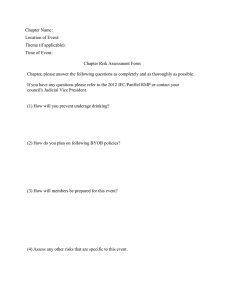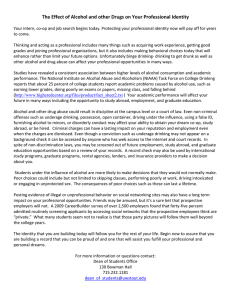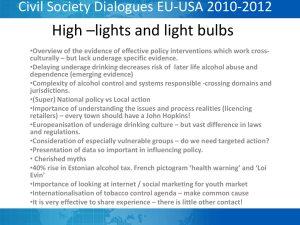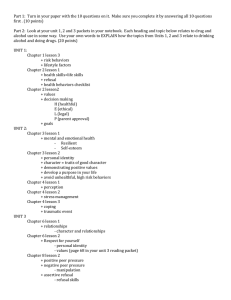Statement by the National Association of State Alcohol and Drug... National Prevention Network (NPN), and National Treatment Network (NTN)
advertisement
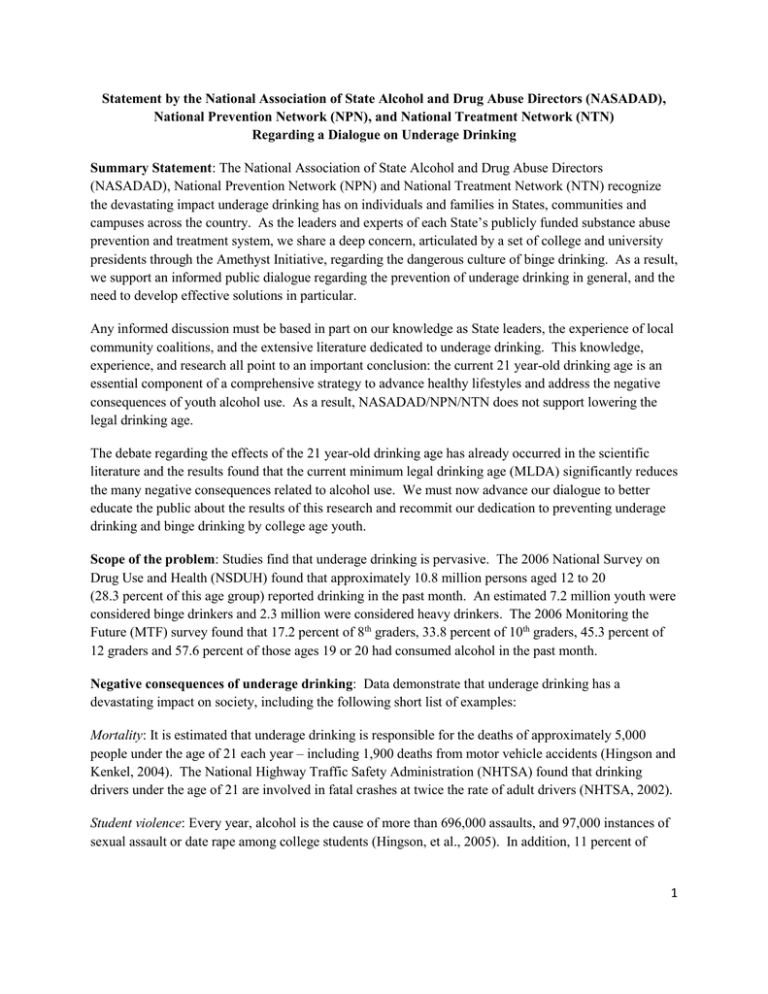
Statement by the National Association of State Alcohol and Drug Abuse Directors (NASADAD), National Prevention Network (NPN), and National Treatment Network (NTN) Regarding a Dialogue on Underage Drinking Summary Statement: The National Association of State Alcohol and Drug Abuse Directors (NASADAD), National Prevention Network (NPN) and National Treatment Network (NTN) recognize the devastating impact underage drinking has on individuals and families in States, communities and campuses across the country. As the leaders and experts of each State’s publicly funded substance abuse prevention and treatment system, we share a deep concern, articulated by a set of college and university presidents through the Amethyst Initiative, regarding the dangerous culture of binge drinking. As a result, we support an informed public dialogue regarding the prevention of underage drinking in general, and the need to develop effective solutions in particular. Any informed discussion must be based in part on our knowledge as State leaders, the experience of local community coalitions, and the extensive literature dedicated to underage drinking. This knowledge, experience, and research all point to an important conclusion: the current 21 year-old drinking age is an essential component of a comprehensive strategy to advance healthy lifestyles and address the negative consequences of youth alcohol use. As a result, NASADAD/NPN/NTN does not support lowering the legal drinking age. The debate regarding the effects of the 21 year-old drinking age has already occurred in the scientific literature and the results found that the current minimum legal drinking age (MLDA) significantly reduces the many negative consequences related to alcohol use. We must now advance our dialogue to better educate the public about the results of this research and recommit our dedication to preventing underage drinking and binge drinking by college age youth. Scope of the problem: Studies find that underage drinking is pervasive. The 2006 National Survey on Drug Use and Health (NSDUH) found that approximately 10.8 million persons aged 12 to 20 (28.3 percent of this age group) reported drinking in the past month. An estimated 7.2 million youth were considered binge drinkers and 2.3 million were considered heavy drinkers. The 2006 Monitoring the Future (MTF) survey found that 17.2 percent of 8th graders, 33.8 percent of 10th graders, 45.3 percent of 12 graders and 57.6 percent of those ages 19 or 20 had consumed alcohol in the past month. Negative consequences of underage drinking: Data demonstrate that underage drinking has a devastating impact on society, including the following short list of examples: Mortality: It is estimated that underage drinking is responsible for the deaths of approximately 5,000 people under the age of 21 each year – including 1,900 deaths from motor vehicle accidents (Hingson and Kenkel, 2004). The National Highway Traffic Safety Administration (NHTSA) found that drinking drivers under the age of 21 are involved in fatal crashes at twice the rate of adult drivers (NHTSA, 2002). Student violence: Every year, alcohol is the cause of more than 696,000 assaults, and 97,000 instances of sexual assault or date rape among college students (Hingson, et al., 2005). In addition, 11 percent of 1 students damaged property while under the influence of alcohol (National Institute on Alcohol Abuse and Alcoholism (NIAAA), 2008). Academic problems: According to the Department of Education (Dept. Ed), alcohol abuse creates academic problems among 25 percent of college students, including lower grades, poor performance on exams or papers, missed classes and failure to keep pace with assignments (Dept. of Ed, 2008). Economic costs: According to the Institute of Medicine (IOM), the economic costs associated with underage drinking equal $53 billion annually due to violent crime, traffic crashes, alcohol poisoning and other factors (Reducing Underage Drinking: A Collective Responsibility, IOM, 2003). Impact on brain development and function: The Surgeon General’s Call to Action to Prevent and Reduce Underage Drinking (2007) summarizes research on the impact of alcohol use by youth, noting that “adolescence is a time when the developing brain may be particularly susceptible to long-term negative effects from alcohol use.” The same Surgeon General’s report informs us that research suggests the brain continues to develop as people enter their twenties, “creating a significant and extended period during its development of potential exposure to alcohol’s harmful effects… (Surgeon General, 2007).” Recent progress and experience: The prevention of underage drinking is a priority for NASADAD/NPN/NTN. While we face many challenges, recent progress is encouraging. Specifically, we note a 21.7 percent decrease in the number of high school seniors reporting lifetime prevalence of alcohol use when comparing 1984 (the year States moved to raise the drinking age to 21 ) and 2007 (MTF, 2007). This progress is attributed to the collective efforts of States, Congress, Surgeon General, Substance Abuse and Mental Health Services Administration (SAMHSA), NIAAA, community coalitions, educators, researchers and many others. In addition, research and experience help produce a better understanding of the complexity of underage drinking – producing more insight into the effects and benefits of the current drinking age. Delaying use increases likelihood of fewer alcohol problems as an adult: Research tells us that people who begin drinking before age 15 are four times more likely to develop alcohol dependence during their lifetime than those who begin drinking at age 21 or later (Grant and Dawson, 1997). The 2006 NSDUH found the rate of alcohol abuse or dependence among adults age 21 or older was 2.4 percent for those who first used alcohol at age 21 or older compared to approximately 10 percent among those who first used alcohol before age 21 and 16.3 percent among those who first used alcohol before age 15. The impact of the minimum legal drinking age: Studies examining the impact of the minimum legal drinking age (MLDA) demonstrate that a number of positive changes have occurred. In 1984, before the age 21 requirement, approximately 8 percent of high school seniors never used alcohol in their lifetime (MTF, 2007). In 2007, approximately 28 percent of high school seniors never used alcohol in their lifetime (MTF, 2007). According to NHTSA, 60 percent of traffic fatalities were alcohol related in 1982. In 2005, approximately 39 percent of traffic fatalities were alcohol related (NHTSA, 2006). The international perspective: Contrary to common assumptions, research has shown that youth and young adults residing in countries that allow alcohol consumption before the age of 21 actually engage in 2 more risky drinking behaviors – not fewer – when compared to the United States. A 2005-2006 study of 40 countries found that the U.S. had one of the lowest rates (36th out of 40) of 13 and 15 year-olds who were drunk at least twice (Health Behavior in School-Age Children, the World Health Organization [WHO], 2008). A 2003 study of 35 countries found that the U.S. had one the lowest rates (33rd out of 35 countries) of youth engaged in binge drinking at least 3 times per month (MTF provided U.S. data for the European School Survey Project on Alcohol and Other Drugs [ESPA], 2003). Research also suggests that when the drinking age is lowered to the age of 18, alcohol-related injuries in 15-17 year olds increase because they have increased access to alcohol through their older friends and siblings (Kypri, 2006). Effective prevention strategies for college age youth are available: According to NIAAA’s A Call to Action: Changing the Culture of Drinking at U.S. Colleges, research has shown that there are a number of effective strategies that help address college drinking (NIAAA, 2002). As noted by NIAAA, “Research shows that several carefully conducted community initiatives aimed at reducing alcohol problems among college-age youth have been effective, leading to reductions in underage drinking, alcohol-related assaults, emergency department visits, and alcohol related crashes (What Colleges Need to Know, NIAAA, 2007).” NIAAA also notes that environmental approaches (including strong enforcement of zero tolerance laws, laws addressing availability, and more) are absolutely crucial. In addition, strategies targeted at the individual level (including alcohol screening, counseling and treatment services) are critical. Other successful approaches include campus-community partnerships; social norms programs or campaigns (addressing permissive attitudes) and the use of web-based technology. Finally, research shows that the use of multiple strategies that are then shaped to address the unique circumstances of the school and community yield success (NIAAA, 2007). Key role of State substance abuse agencies: State substance abuse agency directors, also known as Single State Authorities (SSA), manage and oversee the publicly funded substance abuse system – a system anchored by the federal Substance Abuse Prevention and Treatment (SAPT) Block Grant. SSAs comprise the membership of NASADAD. State prevention directors work for the SSA to provide effective alcohol, tobacco and other drug abuse prevention services and comprise the membership of NPN, a part of NASADAD. The NTN, also a part of NASADAD, is comprised of agency officials who also work for the SSA in promoting effective, clinically appropriate treatment services. A national dialogue about underage drinking greatly benefits from the knowledge, expertise and perspective of NASADAD/NPN/NTN members. Next steps: NASADAD/NPN/NTN members are eager to advance the dialogue regarding the prevention of underage drinking and potential solutions. We encourage this dialogue to include a broad array of stakeholders impacted by youth and college age drinking – including universities, community coalitions, educators, law enforcement, prevention specialists, parents, State agencies, the federal government and many others. In addition, we are eager to forge improved collaboration between State substance abuse agencies and our college and university systems. Underage drinking is indeed a shared responsibility and does not stop at the university gate. We believe increased communication and collaboration can lead to important improvements as we all seek the same goal of promoting and ensuring healthy and safe individuals, families and communities. September 3, 2008 3
